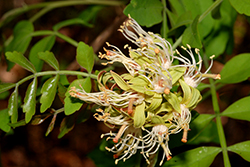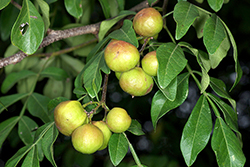e-Flora of Thailand
Volume 2 > Part 4 > Year 1981 > Page 445 > Simaroubaceae > Harrisonia
Harrisonia perforata (Blanco) Merr.wfo-0000715911
Philip. J. Sc. 7: Bot. 236. 1912; Craib in Fl. Siam. En. 1: 243. 1926; Noot. in Fl. Males., Ser. 1, Spermat. 6; 208. t. 9a–e. 1962.— Paliurus perforatus Blanco, Fl. Filip.: 174. 1837.
Accepted Name : This is currently accepted.
Description : Leaves 1–15-jugate, up to ca 20 cm; rhachis narrowly winged, usually with a ribabove, more or less pubescent, especially above; leaflets 10–20 by 5–15 mm; petiole 0.5–3 cm. Branches of cymes and thyrses for some length adnate to the peduncle; pedicels up to 2 mm. Calyx ca 1.5 mm high, lobes ca 0.75 mm. Petals lanceolate, rarely oblong, 6–9 by 2–4 mm. Stamens: anthers ca 1.5–4.5 mm; filaments 7–10 mm; ligule densely woolly at the margin, ca 2 mm. Disk cup-shaped, 1–2 mm high. Ovary 0.5–1 mm high, slightly lobed; style pubescent, 5–8 mm. Fruit 4–9 by 11–15 mm; exocarp coriaceous, at least 1 mm thick; endocarp hard, without a suture.
Thailand : NORTHERN: Mae Hong Son (Mae Sariang), Chiang Mai (Doi Chiang Dao, Doi Suthep, Mae Ho Pa), Lamphun (Doi Khun Tan, Mae Mo), Phrae (Huai Rong), Tak (Lan Sang), Phitsanulok, Sukhothai; NORTH-EASTERN: Phetchabun (Nam Nao), Loei (Dan Sai), Khon Kaen (Pha Nok Khao), Udon Thani; EASTERN: Chaiyaphum (Huai Hin Lat), Nakhon Ratchasima (Pak Chong); CENTRAL: Saraburi (Sam Lan, Muak Lek); SOUTH-EASTERN: Chon Buri (Si Racha), Prachin Buri (Khao Yai), Rayong, Chanthaburi (Pong Nam Ron); SOUTH-WESTERN: Kanchanaburi (Si Sawat), Prachuap Khiri Khan (Bang Saphan).
Distribution : Hainan, Cambodia, Cochinchina, Burma, W Malesia (type).
Ecology : Often on limestone, in deciduous forests, in thickets and along roadside, mostly in open, exposed places,rarely in evergreen forests, up to 900 m alt.
Vernacular : Sifan (สีฟัน), sifan khontha (สีฟันคนฑา), kalantha (กะลันทา)(Central); chi (จี้), namchi (หนามจี้), sito (สีเตาะ)(Northern); khontha (คนฑา)(Southwestern); Kotha (โคทา)(Eastern, Southeastern); mi-chi (มีชี)(Karen-Mae Hong Son).
Uses: The wood and the bark of roots used as an antidiarrhoea and antidysentery.


